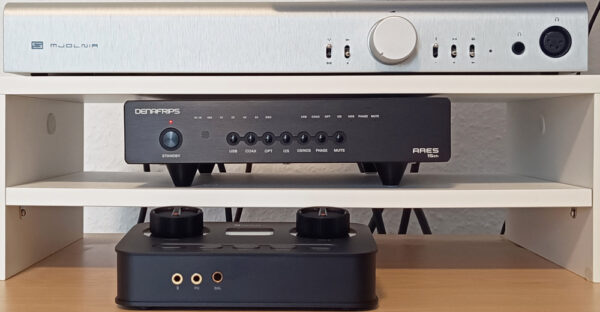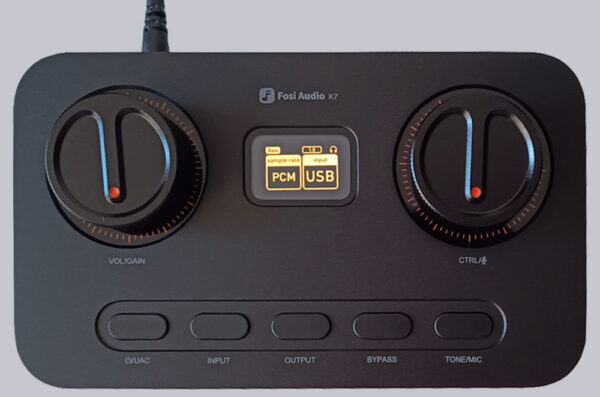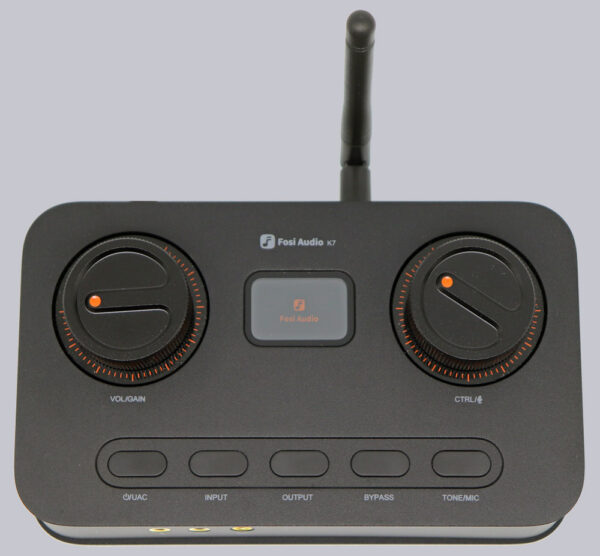
Practical testing …
The USB Type-C input was used for the practical test and as most of the available headphones have a 6.35 mm connection, an adapter for the 600 mW output was used here. The power specifications from Fosi Audio typically refer to 32 Ohm impedance, which is a possible indication of suitability for magnetostats. These often have a lower input impedance, but also a lower sensitivity. However, it should also be possible to supply headphones up to 300 ohms. This applies, for example, to some Sennheiser models with dynamic drivers.
Compared to two external solutions, Fosi Audio primarily saves space in the width and thus some material costs. From personal experience with Monolith and based on descriptions in the audio communities, a less complex circuitry of DAC chips can change the sound. Many forum members find a relatively “bare” AKM DAC chip to be unnaturally detailed in the treble and also “lifeless”, colloquially referring to the lack of natural harmonics. It is a frequent point of contention whether puristic tones with full clarity are preferable or whether those harmonics produce a “fuller” sound. Fosi Audio obviously positions itself on the side of puristic clarity with the lowest levels for THD+N. With regard to the size of the device, it must also be added that the more expensive bolides have internal linear power supplies.

Power consumption …
We also measured the power consumption and it was around 0.3 watts when switched off and between 3.7 and 4.5 watts when switched on, depending on the mode.
Operation …
The operation of the device is described in the manual. OUTPUT is used to switch between headphone supply and RCA (loudspeaker). In EQ mode TONE/MIC, the high or low frequency range can be modulated using the right-hand control. Saved settings can be bypassed using BYPASS when switching to other headphones. Unsurprisingly, INPUT switches to the different inputs. With USB, the power button can also be used to switch between UAC 1.0 and 2.0. The former mode is intended for microphones and should be compatible with the PS5 or Nintendo Switch. In the 2.0 version, the sampling rate is increased to its maximum via USB. This also formed the basis for our music test.
Bluetooth …
Of course, we also tested the Bluetooth connection and were able to pair the Fosi Audio K7 without any problems using the aptX HD Bluetooth codec and operate it as headphones, speakers or other devices.

Display …
Due to the multiple button assignments, the small display in the middle is practically mandatory to show the set mode or EQ settings.

Sound …
In the following test, a direct connection via a jack plug on the PC was used for comparison. It certainly doesn’t make sense to draw a comparison with setups costing well over 1000 Euros. Rather, the question arises as to whether Fosi Audio offers any recognizable added value here compared to onboard solutions. As noted in the tables, two very different headphones from our own collection were used. The subjective sound impressions are reproduced.
| Band/musician and title | Audio devices used | Sound aspects |
|---|---|---|
| Tom Misch – It Runs Through Me | Audeze LCD-2 Classic on the PC | restrained/poor in detail, flat in presentation |
| Tom Misch – It Runs Through Me | Audeze LCD-2 Classic on the K7 | more detailed in the upper mids, too thin in the bass |
| Aurora – Try To Imagine | Audeze LCD-2 Classic on the PC | halfway warm bass, individual layers barely distinguishable |
| Aurora – Try To Imagine | Audeze LCD-2 Classic on the K7 | more sterile bass, individual layers more distinguishable |
| GoGo Penguin – Petit_a | Audeze LCD-2 Classic on the PC | Drums, piano and double bass sit on top of each other spatially |
| GoGo Penguin – Petit_a | Audeze LCD-2 Classic on the K7 | Drums and piano emphasized separately, low frequencies seem to be placed further back |
The Audeze LCD-2C is one of the magnetostats already described, but with 101 dB sensitivity and 70 Ohm impedance it fits quite well in the middle of the headphone market. Its general strength lies in an analytical and very deep bass with an almost linear frequency response in the sub-bass. Due to the thick pads, the action usually seems to be placed a little further away from the ear.
Without an external amplifier effect, 70 ohms is quite sufficient for the computer to run out of breath at high volumes and thus run out of detail. This makes the LCD-2C somewhat boring in terms of presentation, partly because the sound stage is set up far away from the ear. The headphones only maintain their neutrality in the sound image as a positive feature.
On the Fosi Audio K7, on the other hand, Tom Misch’s soft voice and the hi-hats in the song “It Runs Through Me” shine with detail and clarity. This is where the AKM chip really shines through. However, this also applies to the upper bass range and the rapper’s slightly lower tones towards the end of the track, as some power and “warmth” is lost here.
At this point, the neutral LCD-2C needs a counterweight and therefore significantly more energy around 100 Hz, which can be regulated with a bass EQ. 2-3 dB more would be fine. However, the headphones only show their full bass potential with higher-priced amplifiers. Completely without an amplifier, the instruments in Petit_a even sound as if they are in the same small bubble. However, the K7 is also not entirely accurate when it comes to pushing the lowest notes of the double bass quite far into the background. In the studio recording on YouTube at least, the double bass and its microphone are only slightly offset from the other instruments.
| Band/musician and title | Audio devices used | Sound aspects |
|---|---|---|
| Tom Misch – It Runs Through Me | HifiMan HE-R9 on the PC | Bleeding from bass into the frequency range of male voices |
| Tom Misch – It Runs Through Me | HifiMan HE-R9 on the K7 | Voice more clearly lifted from the upper bass range |
| Aurora – Try To Imagine | HifiMan HE-R9 am PC | booming and very warm basses |
| Aurora – Try To Imagine | HifiMan HE-R9 on the K7 | balanced ratio of lighter and darker tones |
| GoGo Penguin – Petit_a | HifiMan HE-R9 on the PC | The piano touches disappear somewhat behind the double bass |
| GoGo Penguin – Petit_a | HifiMan HE-R9 on the K7 | Emphasized hi-hats rival a slightly too warm double bass |
The HifiMan HE-R9 is a closed headphone with a dynamic driver. With 100 dB sensitivity, it corresponds to the LCD2-C, but only has an impedance of 32 ohms, which is exactly the reference value for the power rating. Accordingly, however, it can also be operated quite well on a conventional PC and is not known to be fond of detail anyway.
However, its problem lies in its incredibly dominant bass. Here, the K7 can hold its own, as it creates a stronger balance in “Try to Imagine”, for example, by bringing out the frequency spectrum of the upper mids more strongly by default.
However, such an effect does not always provide a perfect balance. With GoGo Penguin, the upper mids and basses are so strongly emphasized that they are constantly vying for prominence in the foreground.
Gaming …
Although the gaming aspect is primarily covered by the UAC 1.0 mode for PS5 and Switch, the question of spatial representation arises with computer games, i.e. video games on the PC.
During a round of AOE4, we noticed how the more subtle bass and stronger mids meant that brighter medieval music still came through well even with powerful explosions.
However, the spatial staggering with frontal mids and bass positioned at the rear refers to the tonal strengths and weaknesses and not necessarily to the actual events. When a broad line of Janissaries fires simultaneously from a close-up view, the shots should be somewhat more powerful in the foreground than the joyful flute music.
Sabre rattles, flutes and character voices therefore stand out spatially because they are “artificially” separated in their comparable frequency spectrum and appear like larger or optionally closer elements. In any case, this interpretation may be advantageous when communicating with other players, as the fundamental tones of the human voice lie mainly in the lower mid-range, while their harmonics in turn extend into the upper mid-range. This is precisely the broad mid-range in which the K7 seems to have its weight.
Whether this interpretation is dramatic is another matter and is a subjective perception. In any case, the K7 can certainly provide a certain spatiality and, of course, ease of use. You would have to invest considerably more and do without Bluetooth to achieve an even more impressive depth of field, for example in the form of a Lehmann Audio Linear.
Fosi Audio K7 DAC/Amp Overall impression …


